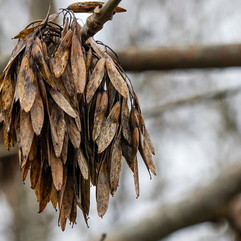Winter Walks: December Colours
- hiddeninnaturedesi
- Dec 29, 2023
- 4 min read
Updated: Dec 5, 2024
I am walking by the swollen banks of the River Tweed, it is a cold and grey day in December but the first dry day when I have been free to go outdoors and walk. As usual my plans to do more walking have been scuppered by rain and the mad frenzy of December, the Christmas month when you suddenly find every weekend booked up.
This is actually my first post in over a year, I have good intentions of writing more, to go alongside my slowly growing collection of wildlife and botanical art, but life and my own procrastination has a way of taking over. Come January I will be more organised and perhaps even get my newsletter going, to share my adventures in the wild and my artwork that is inspired by them, for anyone who is interested.
But for now I’m going to focus on three posts about walking in winter, an enjoyable if slightly chilly pursuit at times. People in the Met office set winter as starting on 1 December and ending on 28 February (though 2024 is a leap year so we get an extra wintry day), but in nature winter is defined by the axis of the earth and its orbit of the sun. Astronomical winter won’t start this year until the 22 December, and though we might grumble that March should herald the return of Spring, winter actually won’t really be over until the middle of March.
So here I am walking at the end of autumn or the beginning of winter on a cold grey day in the Scottish Borders. I’ve actually headed out with the intention of capturing some photos of winter wildlife by the river, a few weeks ago I spotted a kingfisher along the riverside, a bright flash of blue in the dusky landscape, and I dusted off my camera to try and catch this beautiful bird in action. Though after some research online I’ve discovered that kingfishers become a much rarer sight over winter, a harsh winter can be a death sentence for the kingfisher, through cold or starvation.
Twenty minutes into my walk and I haven’t spotted a thing, I’ve heard plenty of songbirds and said hello to a few fellow walkers (looking warmer than me, I misjudged the temperature, and it seems to be dropping), then at last I spot a heron, hunched among a mess of broken branches and dead reeds on a small island, surrounded by the rushing waters. The flood waters have built up a dam of dead wood and leaves that provide a calmer patch of river where two goosanders and several mallards are paddling.
I happily snap away with my camera, reminding myself what all the buttons do (I’m an occasional photographer). The heron looks as cold as I feel, its long neck lost amongst its feathery shoulders; the goosanders object to my presence and decide to head upriver. Finally, I move on when I decide I can only take so many photos of a hunched heron. The path leads me away from the riverbank and up to a road, there’s a steady stream of cars whizzing past and I’m just thinking about putting my camera away when my attention is caught by a small brown bird with a bright yellow crest, a Goldcrest.
The Goldcrest is Britain’s smallest bird and I have only seen them on a handful of occasions. I do my best to photograph the tiny fast-moving bird as it hops from fence to branch and back again, but eventually I give up and simply enjoy watching its antics. When it disappears into a net of branches, I am struck by how much its yellow crest stands out against the browns and greys of the landscape. In summer the bird would be entirely hidden by green leaves, but now in the bare branches of winter the flash of colour is startling.
The Goldcrest flies off and I resume my wanders, but now I’m paying more attention to the few bright colours that jump out at me from among the greys and browns. A spray of red hawthorn berries, the green moss growing on an old stone wall, the shrivelled orange beech leaves still clinging on, blueish green lichen growing on a branch, brownish orange mushrooms that have found a home on the trunk of a tree.
My attention is now caught by a bird almost devoid of colour, the blackbird, a herald of the morning and one of the sweetest sounding birds you will ever find. The male blackbird is perched among the branches of a hawthorn tree, its bright orange beak contrasting starkly with the black feathers and grey twigs, in its beak it holds a single red berry. I manage one photo and then the blackbird seems to take fright, fleeing into the safety of the hedge across the road, only to be replaced in the hawthorn tree by a female blackbird, her duller brown feathers blending in far more easily than the dark male.
The difference between these two birds only strengthens the impact colour has in the winter months, colours stand out far better in winter than they ever would in summer, amongst all the vibrant green they would be lost, but here in the wintry landscape they remind us that nature is still going on. Many of us may have resigned ourselves to short grey days, but there is still so much to see outside.
We should embrace winter, enjoy the cold sharp days, see the bright colours among the grey, welcome the long dark nights and look up at the stars, frosty nights making them even more brilliant than normal. Without natures winter hibernation then there can be no spring, everyone knows this, so let’s enjoy the cold quiet days with their patches of bright colour, and appreciate natures harsher months.
















Comments